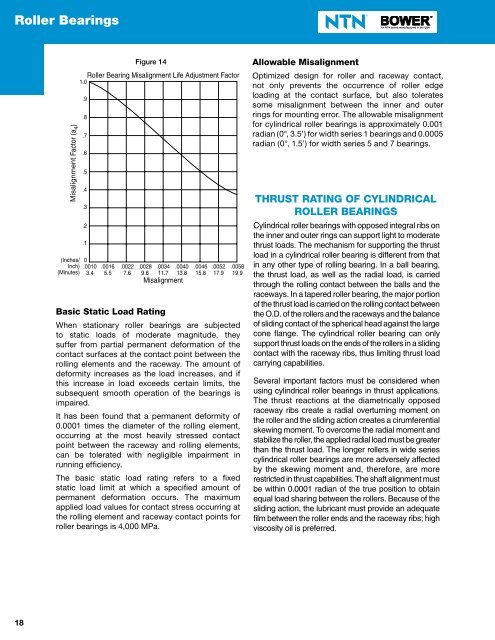Create successful ePaper yourself
Turn your PDF publications into a flip-book with our unique Google optimized e-Paper software.
<strong>Roller</strong> <strong>Bearings</strong><br />
RolleLife Misalignment<br />
Adjustment Factor (a 4<br />
)<br />
Figure 14<br />
<strong>Roller</strong> Bearing Misalignment Life Adjustment Factor<br />
1.0<br />
.9<br />
.8<br />
.7<br />
.6<br />
.5<br />
.4<br />
.3<br />
.2<br />
.1<br />
(Inches/ 0<br />
Inch)<br />
(Minutes) .0010<br />
3.4<br />
.0016<br />
5.5<br />
.0022<br />
7.6<br />
.0028<br />
9.6<br />
.0034<br />
11.7<br />
.0040<br />
13.8<br />
Misalignment<br />
.0046<br />
15.8<br />
.0052<br />
17.9<br />
.0058<br />
19.9<br />
Basic Static Load Rating<br />
When stationary roller bearings are subjected<br />
to static loads of moderate magnitude, they<br />
suffer from partial permanent deformation of the<br />
contact surfaces at the contact point between the<br />
rolling elements <strong>and</strong> the raceway. The amount of<br />
deformity increases as the load increases, <strong>and</strong> if<br />
this increase in load exceeds certain limits, the<br />
subsequent smooth operation of the bearings is<br />
impaired.<br />
It has been found that a permanent deformity of<br />
0.0001 times the diameter of the rolling element,<br />
occurring at the most heavily stressed contact<br />
point between the raceway <strong>and</strong> rolling elements,<br />
can be tolerated with negligible impairment in<br />
running efficiency.<br />
The basic static load rating refers to a fixed<br />
static load limit at which a specified amount of<br />
permanent deformation occurs. The maximum<br />
applied load values for contact stress occurring at<br />
the rolling element <strong>and</strong> raceway contact points for<br />
roller bearings is 4,000 MPa.<br />
Allowable Misalignment<br />
Optimized design for roller <strong>and</strong> raceway contact,<br />
not only prevents the occurrence of roller edge<br />
loading at the contact surface, but also tolerates<br />
some misalignment between the inner <strong>and</strong> outer<br />
rings for mounting error. The allowable misalignment<br />
for cylindrical roller bearings is approximately 0.001<br />
radian (0°, 3.5’) for width series 1 bearings <strong>and</strong> 0.0005<br />
radian (0°, 1.5’) for width series 5 <strong>and</strong> 7 bearings.<br />
THRUST RATING OF CYLINDRICAL<br />
ROLLER BEARINGS<br />
<strong>Cylindrical</strong> roller bearings with opposed integral ribs on<br />
the inner <strong>and</strong> outer rings can support light to moderate<br />
thrust loads. The mechanism for supporting the thrust<br />
load in a cylindrical roller bearing is different from that<br />
in any other type of rolling bearing. In a ball bearing,<br />
the thrust load, as well as the radial load, is carried<br />
through the rolling contact between the balls <strong>and</strong> the<br />
raceways. In a tapered roller bearing, the major portion<br />
of the thrust load is carried on the rolling contact between<br />
the O.D. of the rollers <strong>and</strong> the raceways <strong>and</strong> the balance<br />
of sliding contact of the spherical head against the large<br />
cone flange. The cylindrical roller bearing can only<br />
support thrust loads on the ends of the rollers in a sliding<br />
contact with the raceway ribs, thus limiting thrust load<br />
carrying capabilities.<br />
Several important factors must be considered when<br />
using cylindrical roller bearings in thrust applications.<br />
The thrust reactions at the diametrically opposed<br />
raceway ribs create a radial overturning moment on<br />
the roller <strong>and</strong> the sliding action creates a cirumferential<br />
skewing moment. To overcome the radial moment <strong>and</strong><br />
stabilize the roller, the applied radial load must be greater<br />
than the thrust load. The longer rollers in wide series<br />
cylindrical roller bearings are more adversely affected<br />
by the skewing moment <strong>and</strong>, therefore, are more<br />
restricted in thrust capabilities. The shaft alignment must<br />
be within 0.0001 radian of the true position to obtain<br />
equal load sharing between the rollers. Because of the<br />
sliding action, the lubricant must provide an adequate<br />
film between the roller ends <strong>and</strong> the raceway ribs; high<br />
viscosity oil is preferred.<br />
18

















